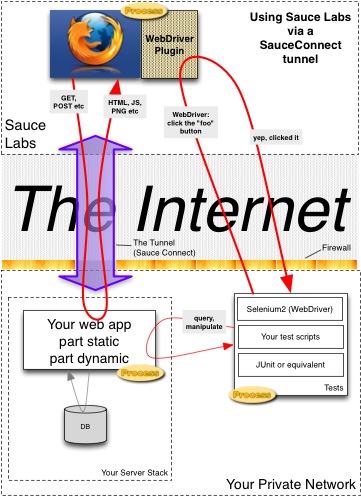Paul Hammant's Blog: Sauce Labs: Tunnels or not?
Below are three architecture diagrams pertaining to Sauce Labs OnDemand usage for parallel testing of webapps with Selenium 1 or 2. You’re using Sauce Labs, of course, if you need 50 to 500 parallel browsers testing a web-app constructed from one or more developer commits - right ?
Using a Sauce Connect Tunnel for content

An illustration of Sauce Labs’ Sauce Connect technology being used to poke through your corporate firewall to the web-server that otherwise is not accepting connections from ‘outside’
Using a Sauce Connect Tunnel for content and commands

As above but the commands from Selenium go the browser also go through the tunnel. While the normal way sends commands over port 80 and/or 443, and your firewall will see them as normal traffic, there could be benefits from marshaling all traffic through on connection (as shown). Sauce’s tunnel doesn’t use ‘Beep’ but if you don’t understand the concepts, a quick read will be helpful.
Publishing your test app directly on the web.

If you deploy the web on a public sub-domain, OnDemand can test it without a tunnel. This is preferable of course, as it will be faster. Most likely you are choosing temporary domain names like 904f628c-23ad-40e6-83f8-48600d242e36.example.com and discarding that as soon as the test suite is complete. There’s some tooling complexity there as you’re doing to have make your DNS dynamic, but nobody said you had to use your main corporate domain.